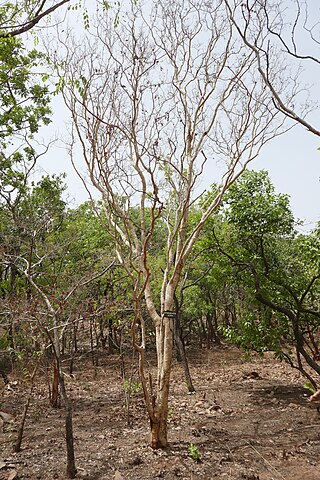
Phyllanthus is the largest genus in the plant family Phyllanthaceae. Estimates of the number of species in this genus vary widely, from 750 to 1200. Phyllanthus has a remarkable diversity of growth forms including annual and perennial herbs, shrubs, climbers, floating aquatics, and pachycaulous succulents. Some have flattened leaflike stems called cladodes. It has a wide variety of floral morphologies and chromosome numbers and has one of the widest range of pollen types of any seed plant genus.

Phyllanthaceae is a family of flowering plants in the eudicot order Malpighiales. It is most closely related to the family Picrodendraceae.

The family Pandaceae consists of three genera that were formerly recognized in the Euphorbiaceae. Those are:
Celianella is a genus of plants belonging to the family Phyllanthaceae first described in 1965. It has only one known species, Celianella montana, native to Guyana and to southern Venezuela. It is dioecious, with male and female flowers on separate plants.

Leptopus, the maidenbushes, are a genus of plants in the family Phyllanthaceae native to southern Asia from the Caucasus east to China and Maluku. The plants are monoecious herbs and shrubs with simple, entire leaves and small, green flowers.

Bischofia is a genus of plants in the family Phyllanthaceae first described as a genus in 1827. It is native to southern China, the Indian Subcontinent, Queensland, New Guinea, and various islands of the Pacific. It is the only member of the tribe Bischofieae. They are dioecious, with male and female flowers on separate plants, but may rarely be monoecious.
Martretia is a genus of plants in the family Phyllanthaceae first described as a genus in 1907. It contains only one known species, Martretia quadricornis, native to western and central Africa from Sierra Leone to Zaire. It is dioecious, with male and female flowers on separate plants.
Leptonema is a genus of flowering plant belonging to the family Phyllanthaceae first described in 1824. The entire genus is endemic to Madagascar. It is dioecious, with male and female flowers on separate plants.
- Leptonema glabrum(Leandri) Leandri
- Leptonema venosum(Poir.) A.Juss.
Ashtonia is a genus of flowering plant belonging to the family Phyllanthaceae first described as a genus in 1968. It is native to the Malay Peninsula and Borneo. It is dioecious, with male and female flowers on separate plants.
- Ashtonia excelsa Airy Shaw - Borneo
- Ashtonia praeterita Airy Shaw - S Thailand, W Malaysia
Distichirhops is a genus of flowering plant belonging to the family Phyllanthaceae. The genus comprises 3 species, found in the secondary forests of New Guinea and Borneo. The taxon name comes from Greek, referring to its distichous leaf arrangement and shrubby habit.
Maesobotrya is a genus of flowering plant belonging to the family Phyllanthaceae first described as a genus in 1879. It is native to sub-Saharan Africa. It is dioecious, with male and female flowers on separate plants.

Richeria is a genus of flowering plant belonging to the family Phyllanthaceae first described as a genus in 1797. It is native to Central America, South America, and the West Indies. Richeria is dioecious, with male and female flowers on separate plants.
- Richeria australis - São Paulo, Mato Grosso
- Richeria dressleri - Costa Rica, Nicaragua, Panama, Ecuador
- Richeria grandis - Panama, N South America, E West Indies
- Richeria obovata - Costa Rica to Bolivia
- Richeria tomentosa - Colombia, Ecuador

Uapaca is a genus of plant, in the family Phyllanthaceae first described as a genus in 1858. It is the only genus comprised in the tribe Uapaceae. The genus is native to Africa and Madagascar. Uapaca is dioecious, with male and female flowers on separate plants.
Didymocistus is a genus of plants in the family Phyllanthaceae first described as a genus in 1940. It contains only one known species, Didymocistus chrysadenius, native to the Loreto region of northeastern Peru, the Amazonas Department of southeastern Colombia, and the State of Amazonas in northwestern Brazil. It is dioecious, with male and female flowers on separate plants.

Hymenocardia is a genus of trees in the family Phyllanthaceae first described as a genus in 1836. Most of the species are native to Africa, with one in Southeast Asia.

Breynia is a plant genus in the family Phyllanthaceae, first described in 1776. It is native to Southeast Asia, China, the Indian Subcontinent, Papuasia, Australia, and the island of Réunion.

Glochidion is a genus of flowering plants, of the family Phyllanthaceae, known as cheese trees or buttonwood in Australia, and leafflower trees in the scientific literature. It comprises about 300 species, distributed from Madagascar to the Pacific Islands. Glochidion species are used as food plants by the larvae of some Lepidoptera species including Aenetus eximia and Endoclita damor. The Nicobarese people have attested to the medicinal properties found in G. calocarpum, saying that its bark and seed are most effective in curing abdominal disorders associated with amoebiasis.
Keayodendron is a genus of plants in the family Phyllanthaceae first described as a genus in 1959. It contains only one known species, Keayodendron bridelioides, native to tropical western and Central Africa. It is dioecious, with male and female flowers on separate plants.
Gonatogyne is a genus of plants in the family Phyllanthaceae first described as a genus in 1873. It contains only one known species, Gonatogyne brasiliensis, endemic to southeastern Brazil. It is dioecious, with male and female flowers on separate plants.

Lachnostylis is a genus of the family Phyllanthaceae first described as a genus in 1846. It is native to the Eastern Cape and the Western Cape Provinces of South Africa. It is often included in Savia. It is dioecious, with male and female flowers on separate plants.
- Lachnostylis bilocularisR.A.Dyer
- Lachnostylis hirta(L.f.) Müll.Arg.









